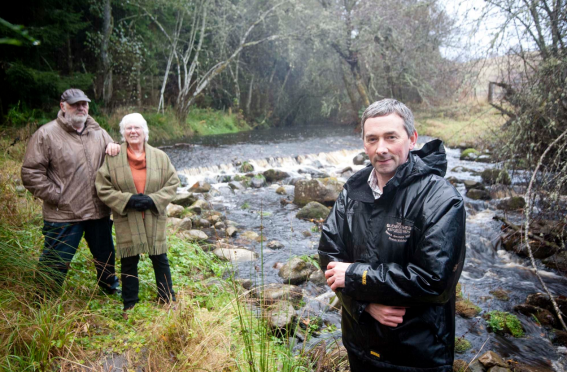Residents in a Speyside village have launched an ambitious £400,000 green energy project – aimed at saving the tiny settlement.
The Knockando Community Trust wants to sell electricity generated by a water turbine and use the cash to rescue their crumbling local hall.
They fear if the 100-year-old building and village focal point closes no one will want to move the area.
Last night, the scheme was hailed as an example for others to follow to keep alive vital community assets.
Trust chairman, Alasdair Anderson, believes the future of Knockando itself would be in jeopardy without the hydro project and a thriving Margach Hall.
He said: “We’re getting help to keep the hall going at the moment but that is going to run out soon.
“The Moray Federation of Halls has had its funding reduced and we’ve had to look to the future to try and protect it.
“I suspect Margach Hall would be finished without the hydro-scheme – we would lose it.
“We’re a small and rural parish and we want it to be attractive for younger families. Without the hall it will just be another reason people don’t want to move here.
“The hall was gifted to the community over 100 years ago. It’s important to preserve it as somewhere to hold functions and groups – even as a loss leader.”
The trust plans to generate renewable energy from a water turbine in the Knockando Burn, which flows into the River Spey.
Calculations done by the group estimate the machine will generate up to £10,000 a year.
Deals have already been struck with distilleries in the area to buy all the power, with the proceeds being used to maintain the village hall and make it free to use.
A new company, Knockando Community Energy, has been set up to manage the proceeds from the venture.
A share scheme is now being launched to fund the project, with the turbine expected to be generating power before the end of next year.
Costs are being kept down by sharing a power connection with the nearby wool mill, with the energy being sold at a rate higher than would be paid for by the National Grid.
Speyside Glenlivet councillor Pearl Paul believes the project could be a “shining example” for other communities to follow.
She said: “It’s a great idea. This is a community that is actually taking action to look after themselves.
“When you think about it, other places could actually do the same too. Rothes has a number of burns coming through it, so do Dufftown and Aberlour.
“It’s quite difficult to fund a lot of local things now and keep halls going so we should all be looking at projects like this.”
Water will flow from the burn into a pipe near an old salmon hatchery.
It will then accelerate over 765 yards while plunging 85ft to increase the efficiency of the turbine.
The water will then arrive in a small powerhouse, which will contain the turbine.
A new walking route to Knockando is also expected to be created on the banks of the burn as part of the project.
Following consultations with the Scottish Environment Protection Agency and the Spey Fishery Board a small fish ladder would also be installed to avoid impacts on migrations.
Mr Anderson’s grandfather was the last person to run a saw mill on the burn in the 19th Century.
He said: “It’s actually quite interesting the way it’s worked out. We’re going to be using the same technology used by the mills.
“We looked at other things like wind turbines but this way we will be churning away power almost 24/7. It will be a lot more steady.”
